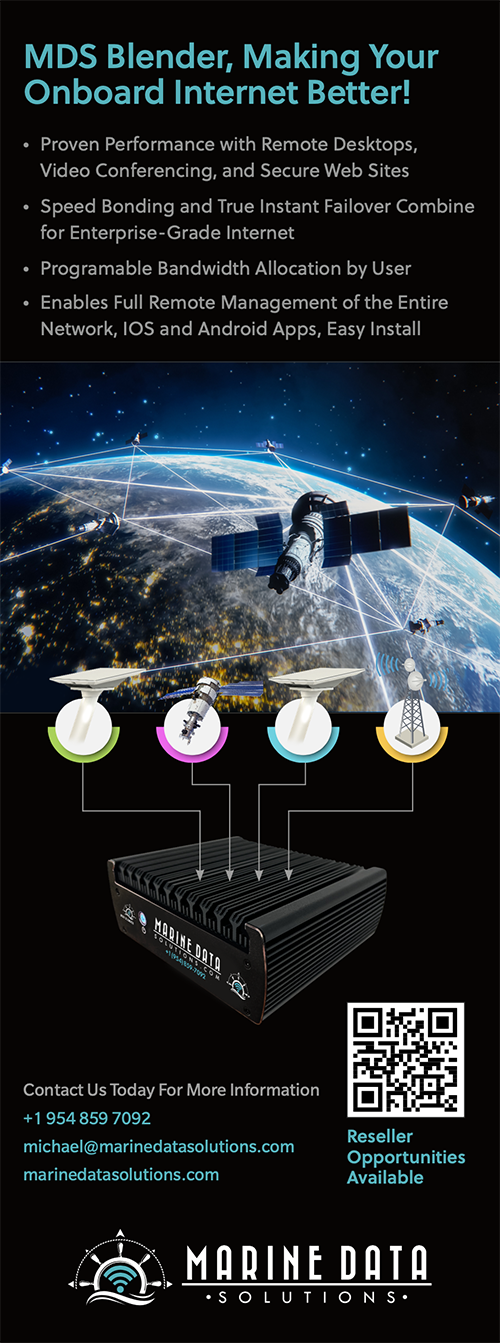Low Earth Orbit, High Speed Satellite, such as Starlink, OneWeb, and Project Kuiper = LEO Sat
LEO Sat FAQ updated 03/05/24
 ⭐ Why Should You Choose Marine Data Solutions for Your LEO Sat Maritime Internet System?
⭐ Why Should You Choose Marine Data Solutions for Your LEO Sat Maritime Internet System?
Marine Data Solutions is a leading provider of maritime internet solutions, offering comprehensive services for LEO Sat system integration on yachts and ships. Our expertise in seamless LEO Sat installation, combined with no additional fees and 24/7 technical support, makes us the ideal choice for enhancing your maritime internet connectivity.
Click here for more info on ext/starlink-mds-blender-and-5g-revolutionizing-maritime-entera fees.
⭐ Enhancing Your LEO Sat Experience at Sea: How Does Marine Data Solutions Achieve This?
Our innovative MDS Blender technology addresses the common challenges of LEO Sat service interruptions, especially under adverse weather conditions and satellite obstructions. This solution effectively combines multiple 5G and LEO Sat systems to deliver uninterrupted, high-speed internet access, ensuring a consistent online experience.
Click here for more info on MDS Blender: More information about MDS Blender
⭐ What Benefits Do Multiple Starlink Antennas Offer for Maritime Internet?
Installing several LEO Sat antennas, integrated with 5G via our MDS Blender, significantly improves both performance and reliability of maritime internet. This setup minimizes the risk of connection obstructions and ensures continuous connectivity, crucial for applications requiring stable internet like remote desktops and video conferencing.
More info on multiple LEO Sat antennas here.
⭐ Starlink vs. Traditional Satellite Internet Systems: What’s the Difference?
LEO Sat’s advanced satellite technology offers lower latency and higher speeds compared to traditional GEO Vsat systems. This makes LEO Sat a more cost-effective and efficient option for maritime internet, providing superior performance for a wide range of maritime activities.
More info on the difference between LEO Sat and legacy GEO Vsat.
⭐ Are There Hidden Costs in LEO Sat Airtime Plans with Marine Data Solutions?
We guarantee transparency in LEO Sat airtime costs. Unlike some providers who may impose additional monthly fees, Marine Data Solutions offers a straightforward and cost-effective solution, allowing direct contracting with Starlink for your maritime satellite internet needs.
Click here for more info on hidden costs.
⭐ Choosing the Right Starlink Antenna for Your Vessel: What to Consider?
We recommend the Mobile High-Performance antenna for optimal maritime broadband experience. Priced at $2500, this antenna is specially designed for motion and international use, ensuring reliable internet connectivity on yachts and ships.
⭐ Does Starlink Impose Data Caps on Maritime Internet Services?
LEO Sat currently offers uncapped data plans for maritime broadband services. Each plan provides a specific amount of priority data, followed by unlimited standard service, accommodating various internet needs at sea.
Click here to request LEO Sat airtime price list PDF: Request Starlink airtime price list PDF
⭐ Understanding LEO Sat Maritime Airtime Costs: What Should You Know?
Starlink’s airtime plans are diverse, ranging from $150 to $6000 per month. The effectiveness of these plans depends on your data usage and the number of LEO Sat antennas installed on your vessel.
Click here to request LEO Sat airtime price list: Click here for more information.
⭐ Can Starlink Be Utilized for Entertainment ?
Yes, LEO Sat, coupled with our MDS Blender technology, revolutionizes on-board entertainment by enabling high-definition streaming and access to online content in remote areas. This technology is a game-changer for maritime entertainment, replacing traditional satellite TV antennas.
Click here for more info on LEO Sat and entertainment systems.
⭐ What Kind of Technical Support Does Marine Data Solutions Offer for LEO Sat?
We provide dedicated 24/7 technical support for all your LEO Sat-related issues. Our team is committed to ensuring the best performance and reliability of your maritime internet system.
⭐ Key Considerations for Optimal LEO Sat System Performance on Vessels:
The effectiveness of your LEO Sat system can be influenced by various factors, including satellite obstructions, weather conditions, and antenna placement in relation to vessel radar beams. Our team provides expert guidance for optimal installation and performance.
⭐ Addressing LEO Sat Network Issues: Why Do Remote Desktops and Video Conferencing Apps Frequently Disconnect?
The current Starlink satellite constellation, being at about 10% of its planned capacity, leads to frequent internet service interruptions, affecting applications like remote desktops and video conferencing. These issues will gradually be resolved as SpaceX expands its satellite network. While we wait for at least 5000 more LEO Sat satellites to launch, you can resolve intermittent LEO Sat service issues with remote desktops, video conferencing, and gaming by adding multiple LEO Sat antennas, and or 5G, and the MDS Blender.
More info on MDS Blender here: More information about MDS Blender
Click here to request Starlink airtime price list PDF: Request Starlink airtime price list PDF
⭐ Best method to connect multiple Starlink Maritime Antennas to a single network
The MDS Blender will allow you to connect up to 4 high speed “sources” (LEO Sat and/or 5G) in any combination. The MDS Blender will Speed Bond up to 4 internet sources, to a maximum speed of 1Gbps, and provide your network with enterprise-grade connectivity, with true instant failover, automatically shifting network traffic to the rest of your working internet sources. This hybrid enterprise grade connectivity is the secret sauce that allows high bandwidth applications to work properly. For example, remote desktops, like AnyDesk and TeamViewer work properly, without constant interruptions, as do video conferencing applications like Teams, Zoom, and WhatsApp. Check out the MDS Blender here: More information about MDS Blender
⭐ Why do Remote desktops like AnyDesk, Splashtop, and TeamViewer stop working several times per hour on Starlink
The LEO Sat constellation of Satellites is projected to have 30,000-40,000 satellites for full high-speed internet coverage of our entire planet. The current number of LEO Sat satellites in orbit, and use is less than 4,000. So we are only at about 10% coverage at this time, for this reason, there are usually multiple times per hour when the LEO Sat internet stops working. When there is no LEO Sat satellite in view, you will not have internet service. When the internet stops working, even for a split second, the remote desktops and Video conferencing apps stop working. Those are the LEO Sat “network issues” that can only be resolved by launching thousands more satellites. (Currently, SpaceX is launching satellites about once a week, with 22 satellites on board for each launch. Those satellites only have a working life of about 5 years before they must be replaced…. Based on those factors, the math appears to tell us that it will be many years before we have full coverage from LEO Sat) Check out the MDS Blender here: More information about MDS Blender
⭐ Why do video conferencing apps like Zoom and Teams stop working several times per hour on LEO Sat
The LEO Sat constellation of Satellites is projected to have 30,000-40,000 satellites for full high-speed internet coverage of our entire planet. The current number of LEO Sat satellites in orbit, and use is less than 4,000. Currently we are only at about 15% coverage at this time, for this reason, there are usually multiple times per hour when the LEO Sat internet stops working. When there is no LEO Sat satellite in view, you will not have internet service. When the internet stops working, even for a split second, the remote desktops and Video conferencing apps stop working. Those are the LEO Sat “network issues” that can only be resolved by launching thousands more satellites. (Currently, SpaceX is launching satellites about once a week, with 22 satellites on board for each launch. Those satellites only have a working life of about 5 years before they must be replaced…. Based on those factors, the math appears to tell us that it will be many years before we have full coverage from LEO Sat) Check out the MDS Blender here: More information about MDS Blender
Click here to request a price list.
⭐The Promise of LEO Sat for Maritime Connectivity
The emergence of Low Earth Orbit (LEO) satellite systems like Starlink, OneWeb, and Project Kuiper heralds a new era of high-speed maritime internet connectivity. These innovative satellite constellations promise lower latency and higher speeds compared to traditional satellite systems, revolutionizing the way vessels stay connected at sea. With Marine Data Solutions’ expertise in LEO Sat integration and our commitment to delivering seamless internet experiences, yacht owners and maritime operators can trust us to keep them connected wherever their adventures take them.
⭐Unlocking the Potential of LEO Sat with Marine Data Solutions
Marine Data Solutions is dedicated to unlocking the full potential of LEO Sat technology for maritime applications. Our comprehensive services, including system integration, technical support, and innovative solutions like the MDS Blender, ensure that yacht owners and maritime operators can harness the power of LEO Sat to enhance their onboard connectivity. With Marine Data Solutions as your partner, you can navigate the seas with confidence, knowing that you have a reliable and efficient internet solution at your fingertips.
⭐The Importance of Reliable Maritime Internet
In today’s digital age, reliable internet connectivity is essential for conducting business, staying connected with loved ones, and accessing vital information while at sea. Whether you’re a yacht owner, charter guest, or crew member, having uninterrupted internet access is crucial for productivity, communication, and entertainment. Marine Data Solutions understands the importance of reliable maritime internet, which is why we offer cutting-edge solutions like the MDS Blender to ensure that your internet connection remains stable and consistent, no matter where your voyage takes you.
⭐Navigating the Complexities of Maritime Connectivity
As technology continues to evolve, so too does the complexity of maritime connectivity. With multiple satellite systems, varying coverage areas, and regulatory considerations to navigate, choosing the right internet solution for your vessel can be challenging. That’s where Marine Data Solutions comes in. Our team of experts specializes in navigating the complexities of maritime connectivity, providing tailored solutions to meet the unique needs of each client. Whether you’re seeking high-speed internet for business or leisure, Marine Data Solutions has the expertise to keep you connected.
⭐Looking Towards the Future of Maritime Connectivity
As we look towards the future, the possibilities for maritime connectivity are endless. With advancements in satellite technology, the expansion of LEO Sat constellations, and the continued innovation of companies like Marine Data Solutions, the future of maritime connectivity has never looked brighter. By partnering with industry leaders and leveraging cutting-edge technology, we are committed to shaping the future of maritime communication and ensuring that yacht owners and maritime operators have access to reliable, high-speed internet wherever their journeys take them.</p
Conclusion
Marine Data Solutions offers unparalleled expertise in LEO Sat maritime internet solutions. Our commitment to providing high-quality, reliable internet services with advanced technology like the MDS Blender ensures that your maritime operations remain connected and efficient. Contact us to elevate your maritime connectivity experience.


